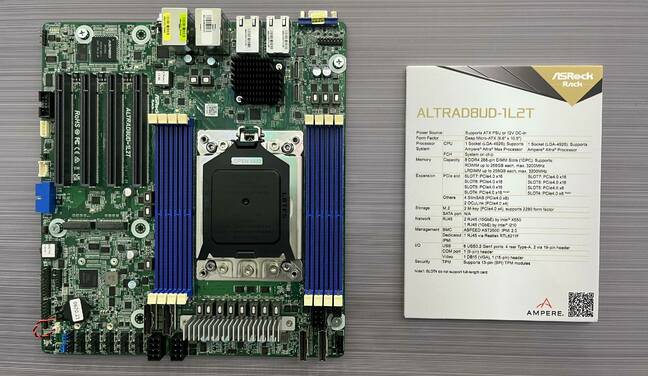Taiwan's Titans Bullish On Challengers To X86 In The Datacenter And Beyond
Computex Taiwan's annual Computex exhibition grew up as the world's premier forum for everything to do with PCs, and later became a celebration of the island's outsized role in the ecosystem.
The territory's tech industry has diversified since, and has added outsized influence on enterprise hardware and semiconductors. But the event's show floor nonetheless remains dominated by gaming PCs – and kit to speed them up, cool them down, and make them pretty.
The stand operated by Taiwanese motherboard maker ASRock offers a typical display of tech bling.
But tucked away on the stand is something more interesting to The Register: the Rack ALTRAD8U-1L2T, ASRock's first motherboard built for Ampere's Altra and Altra Max CPUs – manycore affairs that use the Arm architecture.
The board isn't even on ASRock's website yet. But the Altra architecture is already present in clouds run by Oracle and Microsoft, as the two giants offer it to their customers as a way to run cloudy workloads at lower cost than they can offer with x86 silicon.
Ampere is just five years old, so has done well to bring silicon to market in such a short time – never mind score such prestigious customers.
In a keynote at Computex on Wednesday, Ampere chief product officer Jeff Wittich hailed ASRock's motherboard as a noteworthy sign of increasing interest in Altra for on-prem workloads. He's right: ASRock's server business is modest, but the venture is owned by giant contract manufacturer Pegatron. Clearly someone sees decent upside in supporting Ampere in more applications.
Wittich then offered more evidence of that interest, by interviewing Martin Ting, CEO of Taiwanese OEM 7StarLake. Ting revealed his biz has created three rugged server designs using the Altra.
Ting mentioned a very significant US aerospace company, and a colossal multinational railway infrastructure concern, as expressing very strong interest in those servers – on grounds that Arm-based CPUs are eminently suited to the planes and train they make.
Wittich followed a talk from the senior veep and GM of Arm's infrastructure business, Mohamed Awad, who told the conference Taiwan's tech ecosystem is bullish about Arm's Neoverse server-class designs and is putting in the same kind of effort that catalyzed the smartphone industry around the Arm platform
Awad is of course paid to talk up his employer's prospects. But he seemed sincere in his belief that the partners Arm needs to win over to make Neoverse a contender have come out to play.
- Qualcomm imagines constellation of Snapdragons sharing AI workloads
- Intel says AI is overwhelming CPUs, GPUs, even clouds – so all Meteor Lakes get a VPU
- Nvidia creates open server spec to house its own chips – and the occasional x86
- Look mom, no InifiniBand: Nvidia’s DGX GH200 glues 256 superchips with NVLink
The Arm/Ampere presentation followed Nvidia CEO Jensen Huang's opening day delivery of his vision for servers built around accelerators his enterprise makes, instead of centering on CPUs. Nvidia created an open server spec to deliver that vision.
And again, Taiwan's titans were there for it: Supermicro and QCT already revealed their planned products using that spec, and more Taiwanese players have promised to do likewise – soon.
In the Computex press room, The Register chatted about Huang's keynote with journos who focus on gaming and PCs. One expressed disappointment that the Nvidia CEO spent only ten or fifteen minutes on gaming before devoting 90 minutes to servers and accelerator architectures – and who cares about that?
With Taiwan's major tech manufacturers showing signs they believe Arm, Ampere, and Nvidia represent their next opportunity, all of us do – if only because it shows maturing competition for enterprise workloads and therefore more choices to consider. And those gaming fans don't know it yet, and may never need to care, but the clouds that power their preferred amusements will also change as a result of the attitudes aired at this year's Computex. ®
From Chip War To Cloud War: The Next Frontier In Global Tech Competition
The global chip war, characterized by intense competition among nations and corporations for supremacy in semiconductor ... Read more
The High Stakes Of Tech Regulation: Security Risks And Market Dynamics
The influence of tech giants in the global economy continues to grow, raising crucial questions about how to balance sec... Read more
The Tyranny Of Instagram Interiors: Why It's Time To Break Free From Algorithm-Driven Aesthetics
Instagram has become a dominant force in shaping interior design trends, offering a seemingly endless stream of inspirat... Read more
The Data Crunch In AI: Strategies For Sustainability
Exploring solutions to the imminent exhaustion of internet data for AI training.As the artificial intelligence (AI) indu... Read more
Google Abandons Four-Year Effort To Remove Cookies From Chrome Browser
After four years of dedicated effort, Google has decided to abandon its plan to remove third-party cookies from its Chro... Read more
LinkedIn Embraces AI And Gamification To Drive User Engagement And Revenue
In an effort to tackle slowing revenue growth and enhance user engagement, LinkedIn is turning to artificial intelligenc... Read more


